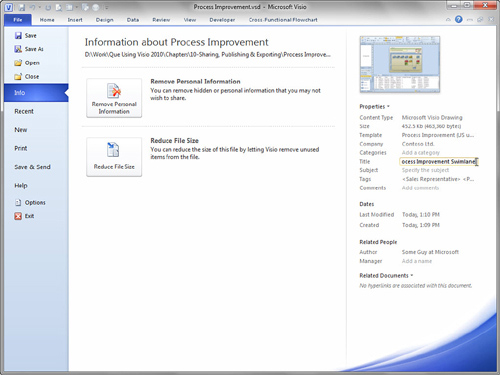Before you share a Visio document, you
might want to change or remove certain bits of sensitive in-house
information and reduce the file size as much as possible. The Info
panel in the Backstage area offers several functions to help you do
this.
Setting Document Properties
When you click the Info tab in the Backstage area, you see something like Figure 1,
which shows two big buttons for removing information and reducing file
size, along with summary of information fields under Properties on the
right.

If you’ve used Microsoft Office for a long time, you
might be used to editing document properties such as Author, Title,
Company, Categories, and so on via a pop-up accessible from File,
Properties.
With the new Backstage area, it took me awhile to
notice that you can actually edit several of these fields in-place.
Just mouse over the fields on the right; orange highlights around a
field indicate that it is editable. In Figure 1, the Title field is being edited.
You
can still access the “old” properties dialog by clicking the little
Properties item just under the preview thumbnail and choosing Advanced
Properties. The pop-up dialog also has a few more fields and settings
than are shown in the Info panel.
Removing Personal Information
Before you email a document outside the company, you
might want to erase some of those document property fields, along with
other information. On the Info panel, click the Remove Personal
Information button. The Remove Hidden Information dialog appears, with
the Personal Information tab active.
Which Information Gets Removed?
The Personal Information tab has a few check boxes that enable you to clear quite a bit of information from your document:
File properties (author, company, manager, and so on)
Reviewer comments
Reviewer marks and pages
Stencil file paths
Template filename
Validation issues and time stamp
External data sources
Stencil file paths and template filenames could give
someone an unwanted look into the directory structure of your PC or
your company’s infrastructure.
Although validation issues can be generated only by
Visio Premium, they might still take up space in a document, even if it
is being edited in Standard or Pro.
Which Information Isn’t Removed?
Determining
which information isn’t removed is the tricky bit, of course. Shape
Data fields aren’t erased, even when data sources are removed from a
document. If you’ve populated an org chart with salary data, people can
still see this data by inspecting the Shape Data fields for shapes.
Data Graphics applied to such shapes reveal this data visually as well.
If you’ve used callouts or text blocks to add
comments to a drawing, Visio isn’t able to remind you to remove it. So
if you add a comment to a callout attached to a process shape that says
“Duration should be 3.5 hours, but Bob needs 6,” information removal
won’t catch it.
Multipage documents can be dangerous, too, because
the tabs can sometimes be off the edge, out of sight and out of mind.
Make sure that you haven’t retained any “junk” or “test” pages
unintended for external eyes.
Reducing File Size
The second tab in the Remove Hidden Information
window is the File Size Reduction tab. You can also jump straight to it
by clicking the Reduce File Size button in the Info panel.
The things that you can clean up to make your Visio file smaller include
The preview picture
Unused master shapes
Unused themes, data graphics, and styles
Inactive validation rule sets
The preview picture usually isn’t a huge detail,
especially with today’s large hard drives. But unused masters, themes,
data graphics, and styles can really add up.
Validation rule sets are a feature that is useful
only to Visio Premium users, but the rule sets can still take up space
in a document, even if it is being edited in Standard or Pro.
I’ve seen files from customers that contain, say, a
simple flowchart. A simple diagram, but the file is a whopping 3MB!
What often happens is that they experiment with every shape they can
get their mouse on. They drop one, play with it, explore its features,
and then delete it. But it remains in the Document Stencil.
The File Size Reduction tab is very informative and
tells you how many unused objects you have, so you can tell whether you
have a cluttered document before you commit to removing the items.
Reducing your Visio file sizes not only
helps keep your hard drive free, but also keeps you on the happy side
of folks to whom you mail attachments. These features are a great
addition to Visio and well worth learning.